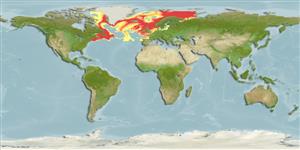>
Pleuronectiformes (Flatfishes) >
Pleuronectidae (Righteye flounders) > Pleuronectinae
Etymology: Hippoglossoides: Greek, ippos = horse + Greek, glossa = tongue + Suffix oides = similar to (Ref. 45335).
Environment: milieu / climate zone / depth range / distribution range
Ökologie
seewasser demersal; ozeanodrom (Ref. 51243); tiefenbereich 10 - 3000 m (Ref. 58426), usually 90 - 250 m (Ref. 6263). Temperate; 80°N - 41°N, 72°W - 55°E
Western Atlantic: southern Labrador in Canada and western Greenland to Rhode Island in USA; Eastern Atlantic: off eastern Greenland and from the English Channel to the coast of Murmansk (Ref. 7251). Two subspecies were recognized, H. p. platessoides from northwestern Atlantic, and H. p. limandoides from the northeastern Atlantic (Ref. 51668).
Length at first maturity / Size / Gewicht / Alter
Maturity: Lm 35.0 range ? - ? cm
Max length : 82.6 cm TL Männchen/unbestimmt; (Ref. 58426); max. veröff. Gewicht: 6.4 kg (Ref. 7251); max. veröff. Alter: 30 Jahre (Ref. 6263)
Slender body and a large mouth. Dorsal fin starts above left eye. Lateral line almost straight. Rough scales (Ref. 35388).
Adults are most abundant from 90 m to 250 m deep and bottom temperatures of -0.5 to 2.5°C (Ref. 6263). Live on soft bottoms (Ref. 9988, 58426). Feed on invertebrates and small fishes. Batch spawner (Ref. 51486). Marketed fresh and frozen; eaten steamed, fried, microwaved and baked (Ref. 9988).
Cooper, J.A. and F. Chapleau, 1998. Monophyly and intrarelationships of the family Pleuronectidae (Pleuronectiformes), with a revised classification. Fish. Bull. 96(4):686-726. (Ref. 30193)
IUCN Rote Liste Status (Ref. 130435)
Bedrohung für Menschen
Harmless
Nutzung durch Menschen
Fischereien: hoch kommerziell
Tools
Zusatzinformationen
Download XML
Internet Quellen
Estimates based on models
Preferred temperature (Ref.
123201): 0.6 - 10.3, mean 5.6 °C (based on 824 cells).
Phylogenetic diversity index (Ref.
82804): PD
50 = 0.5625 [Uniqueness, from 0.5 = low to 2.0 = high].
Bayesian length-weight: a=0.00646 (0.00554 - 0.00753), b=3.06 (3.02 - 3.10), in cm total length, based on LWR estimates for this species (Ref.
93245).
Trophic level (Ref.
69278): 4.1 ±0.0 se; based on diet studies.
Generation time: 13.1 (8.8 - 14.5) years. Estimated as median ln(3)/K based on 12
growth studies.
Widerstandsfähigkeit (Ref.
120179): niedrig, Verdopplung der Population dauert 4,5 - 14 Jahre. (rm=0.43; K=0.06-0.12; tm=2-11; tmax=30; Fec=50,000).
Fishing Vulnerability (Ref.
59153): High to very high vulnerability (66 of 100).
Climate Vulnerability (Ref.
125649): Moderate to high vulnerability (46 of 100).
Nutrients (Ref.
124155): Calcium = 19.2 [7.5, 32.8] mg/100g; Iron = 0.214 [0.105, 0.410] mg/100g; Protein = 17.1 [15.7, 18.5] %; Omega3 = 0.407 [0.194, 0.867] g/100g; Selenium = 31.2 [15.1, 68.7] μg/100g; VitaminA = 8.07 [1.81, 36.72] μg/100g; Zinc = 0.336 [0.224, 0.512] mg/100g (wet weight);
